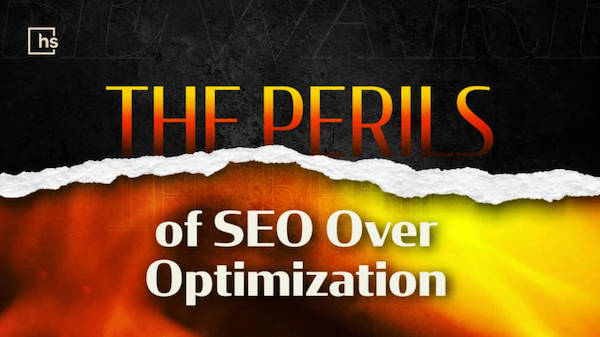
SEO is a good thing.
It’s the original bridge between Google search crawlers and people; it is the only way search engines better understand and retrieve what consumers are organically searching for online.
But did you know that you can overdo SEO?
It’s called over optimization, and it happens all the time.
A common example is a website with multiple pages on the same topic. On the surface, going after the same keywords multiple times seems like a good idea. But with Google, this approach results in all of those pages ranking poorly.
In this blog post, I share some of the most common over optimization problems we face when auditing healthcare websites.
I also give tips on how to avoid them.
Note: This post won’t cover black hat SEO tactics in detail, but we recommend brushing up on those to avoid the Google blacklist.
We see over optimization on virtually every healthcare site we audit.
Here are 12 examples:
Does your website read like a broken record? This is the old-school over optimization tactic and one of the first SEO black hat techniques. It means your content is stuffed with too many target keywords. Keep primary keywords to about once every 200 words.
Too many keyword-rich anchors (in-text links) that exactly match internal or external URLs. Use synonyms instead.
Google considers stuffing your footers, sidebars, and heading tags with keywords black hat SEO and could earn you a devastating Google penalty. Instead, keep your header and footer simple and use keywords strategically in H1 and H2 tags (and only when they directly describe or support the copy that follows).
Avoid overlapping or similar pages, topics, and content across your site. This was the example I shared above, and it’s called keyword cannibalism. Whether done on purpose or as a result of an older site, it’s often a reflection of a poor SEO strategy and bad site architecture, which means the information on your website is not properly organized.
A trending keyword, phrase, or event can often help improve your page rank. However, publishing content that targets off-niche or irrelevant keywords can damage your page rank. Your website reflects your business. As a result, each page topic must reflect a part of what you do or sell.
Long-form SEO content (+1,500 words) is king and a great way to establish brand authority in your niche. The average article length on an organic search result in the #1 slot is 1,890 words. However, long-form articles are useless and often harm your SEO strategy. Every piece of content you write must:
Content has multiple H1 tags on a single page. Keep it to a single H1, and follow with H2s, H3s, and H4s as needed.
Avoid excessive use of "money keywords" in your in-text links. Internal and external links that match another page's name or primary keyword can lead to an over optimization penalty. It's also important to avoid linking your content to sites with low domain authority. This can damage your site's authority as it is a method by which search engines determine the usefulness and quality of your pages.
Avoid publishing content that only links internally to top-level navigation pages. Instead, use deeper internal links to strengthen your link profile. For example, if you have a top-level service page, try linking to a secondary page within that section to give readers more in-depth information.
Placing hidden text on web pages is spam, especially if it's done to manipulate search algorithms to drive more traffic. This black hat SEO tactic could earn your site a hefty Google penalty, including lower SERP results.
Search engines want to share original content in response to each query. If you're sharing duplicate copy across different domains, you must tell Google which URL is the original so that Google can crawl it more often than the rest. This is called canonicalization. Be sure your canonical tags are coded correctly to avoid a Google penalty.
Avoid non-branded, keyword-dense domain names, as they could trigger a Google penalty—especially if you’re over-optimized in other areas. Instead, keep domain names simple, or use your brand name.
As Google evolves, so do SEO best practices.
The best way to avoid over-optimization is to familiarize yourself with the “Google Zoo.” These content-focused updates are a part of Google’s core algorithm and can help you stay on Google’s good side.
The Google Zoo, which consists of Panda, Penguin, and Hummingbird, comprises Google's most significant algorithm updates that help determine where sites rank on the search results page.
Each animal has a different function. However, each one identifies and reports over-optimization and black hat SEO issues.
If you stay up-to-date with Google's latest algorithm changes and keep your content focused on your users' search intent, you'll have a well-rounded SEO strategy and avoid several common pitfalls of over-optimization.
Stewart Gandolf
Chief Executive Officer
The original version of this page was published at: https://healthcaresuccess.com/blog/seo/the-perils-of-seo-over-optimization.html
Founded in 2006, Healthcare Success is a respected, full-service brand performance marketing agency focused on healthcare and recognized as a thought-leader in the industry.
While we are very excited to announce our agency just launched our new website featuring a brand-new design, functionality, backend tech, and fresh content, we expect you’ll ...read more
As a hospital or health system, you know the value of patient engagement. You understand that it’s crucial for improving the overall patient experience and health outcomes ...read more
When done correctly, healthcare content can build trust and turn people into lifelong supporters of your brand. At the same time, creating superior health or wellness content can be ...read more
More companies are making high-quality healthcare easier to access and more affordable by embracing data and technology. While healthcare has historically been among the slowest to ...read more